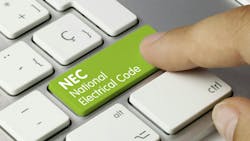This is a term normally used in combination with another term (there are several) and in the context of a hazardous location [Art. 100]. Something that is nonincendive is incapable of causing the ignition of a specified flammable gas-air or vapor-air mixture under normal operating conditions or intended use. This definition varies a bit depending upon what term you use with “nonincendive.” If you’re referring to a non-incendive circuit, equipment, or field wiring, you would also add “dust-air” to the list of mixtures. In fact, only with “non-incendive component” is dust left out.
Here are examples of nonincendive components:
- Circuit. A circuit other than field wiring.
- Component. It has contacts for making or breaking an incendive circuit and the contacting mechanism. Its housing is not intended to exclude the flammable atmosphere or contain an explosion.
- Equipment. The reference is to its electrical and/or electronic circuitry.
- Field wiring. This is wiring that enters or leaves an equipment enclosure. Normal operations include opening, shorting, or grounding the field wiring.
Another term used with “nonincendive” is “field wiring apparatus.” It’s just apparatus intended to be connected to the field wiring. Article 100 doesn’t explicitly say it won’t ignite gas or whatever as it does for all of the other terms, but common sense tells us that is the case. Taking “nonicendive” from this list of combined terms and defining it first as we did also makes this clear.
About the Author

Mark Lamendola
Mark is an expert in maintenance management, having racked up an impressive track record during his time working in the field. He also has extensive knowledge of, and practical expertise with, the National Electrical Code (NEC). Through his consulting business, he provides articles and training materials on electrical topics, specializing in making difficult subjects easy to understand and focusing on the practical aspects of electrical work.
Prior to starting his own business, Mark served as the Technical Editor on EC&M for six years, worked three years in nuclear maintenance, six years as a contract project engineer/project manager, three years as a systems engineer, and three years in plant maintenance management.
Mark earned an AAS degree from Rock Valley College, a BSEET from Columbia Pacific University, and an MBA from Lake Erie College. He’s also completed several related certifications over the years and even was formerly licensed as a Master Electrician. He is a Senior Member of the IEEE and past Chairman of the Kansas City Chapters of both the IEEE and the IEEE Computer Society. Mark also served as the program director for, a board member of, and webmaster of, the Midwest Chapter of the 7x24 Exchange. He has also held memberships with the following organizations: NETA, NFPA, International Association of Webmasters, and Institute of Certified Professional Managers.
